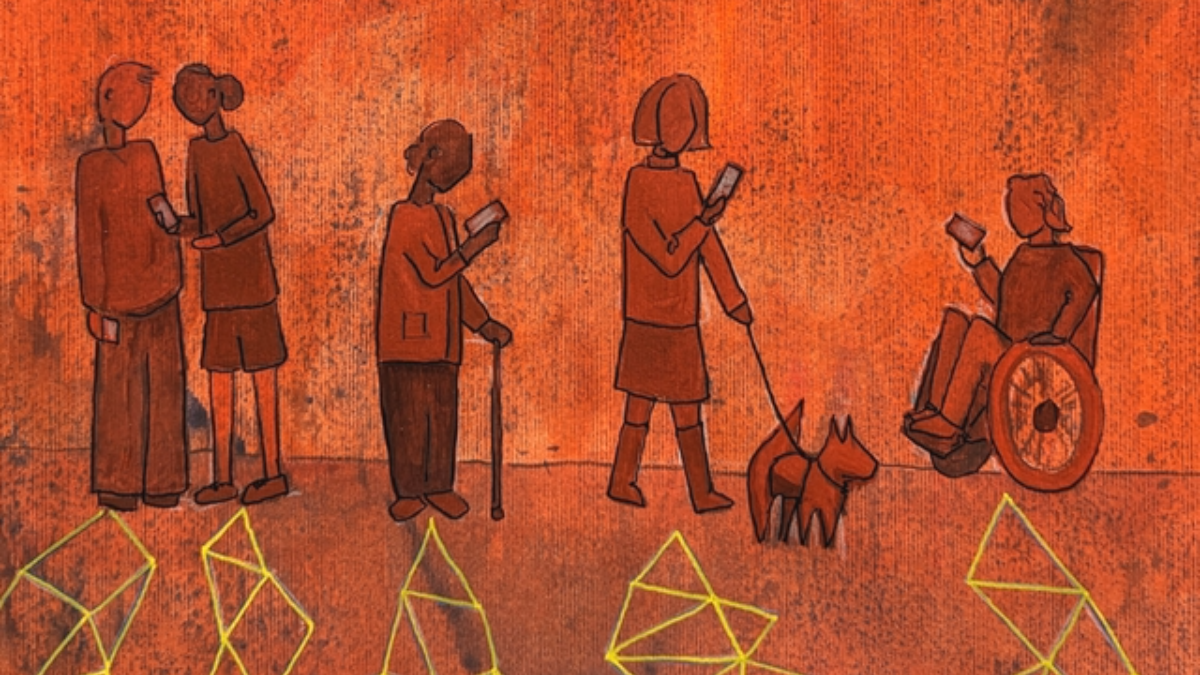The Universal Service Fund Is Legal—Now Make It Legitimate
Danielle A. Davis / Oct 29, 2025Danielle A. Davis, Esq., is the director of technology policy at the Joint Center for Political and Economic Studies.

Jamillah Knowles & Reset.Tech Australia / Better Images of AI / People with phones / CC-BY 4.0
The Supreme Court’s decision in Consumers’ Research v. FCC may have ended the long-running debate over whether the Universal Service Fund (USF) is constitutional, but it did not resolve the more urgent question before Congress and the Federal Communications Commission: whether the USF we have is fit for the digital economy we live in. Created for the age of dial tone, the fund now supports the basic infrastructure of modern life: school, work, health care, and civic participation. Its programs and financing no longer match how Americans—especially Black Americans—connect and stay connected.
At the Joint Center for Political and Economic Studies—America’s Black think tank—our mission for more than fifty years has been to confront structural barriers to Black freedom with evidence, analysis, and practical solutions. In recent years, that work has increasingly meant confronting the digital divide as a driver of economic mobility, educational attainment, health outcomes, and democratic participation.
As someone who previously served as Assistant General Counsel for USAC—providing legal guidance on both Lifeline and the Affordable Connectivity Program (ACP)—I’ve seen firsthand how much depends on a strong, sustainable affordability framework. The reality is simple: Black households, low-income consumers, and digitally redlined communities cannot meaningfully participate in the digital economy without reliable, affordable broadband. And right now, our federal systems aren’t meeting that need.
That is why the Joint Center recently submitted comments to Congress’s bicameral USF Working Group, urging reforms that stabilize affordability, center equity, and meaningfully include low-income Black households in the future of universal service. Broadband now underpins economic mobility, education, health, and civic participation; yet affordability remains the central barrier. In the Black Rural South, for example, 38 percent of African Americans report lacking home internet access, with cost frequently cited as the reason. Affordability is not a peripheral concern; it is the fulcrum that determines whether families can participate fully in twenty-first-century life or are pushed to its margins.
The promise of ACP and the cost of its collapse
That is why the ACP program mattered so profoundly. Although ACP was never part of the USF, it became the nation’s most consequential affordability subsidy, helping more than 23 million households—more than 5 million of them being Black—stabilize or obtain broadband through a monthly discount of up to $30, or $75 on Tribal lands.
When ACP lapsed in May 2024 due to congressional inaction, the impact was swift and punishing. Families who had paired ACP with the $9.25 Lifeline benefit lost essential support that made service affordable. Parents downgraded speeds, discontinued medical appointments, and cut back on essentials to keep connections alive; others endured cycles of disconnection and reconnection that rippled through their children’s schooling and their own employment. These are not abstract “market adjustments.” They are the daily costs of a policy choice that relied on a temporary program to make internet service affordable to and when the politics shifted, allowed it to vanish.
Lifeline’s limits and the case for a permanent affordability mechanism
It is tempting to treat this episode as an unfortunate anomaly, yet it exposes a deeper design flaw. A modern universal service regime cannot depend on intermittent appropriations or the vagaries of partisan mood. If affordability is the hinge on which digital opportunity turns, then stability must be built into the architecture of universal service itself. That requires either embedding an ACP-like benefit within USF or modernizing Lifeline so that it functions as a genuine broadband affordability program—one with a benefit sized to contemporary prices and an enrollment process that is streamlined, dignified, and accessible.
The case for reform becomes even clearer when we examine Lifeline as it exists today. Lifeline remains the only permanent affordability tool under USF, yet it was conceived in 1985 for a world where voice service was the defining communications technology. Even before ACP, the Lifeline program’s limits were evident. By 2021, only about 6.9 million households were enrolled in the program despite more than 33 million qualifying for it. And as of June 2025, Lifeline enrollment had risen only modestly to roughly 8.1 million, which amounts to about 21 percent of eligible households.
The benefit has not kept pace with broadband prices, and the program’s administrative burdens and stigma depress participation further. Expecting Lifeline, without significant modernization, to shoulder the entire burden of affordability is asking a landline program to solve a broadband problem—an approach structurally incapable of meeting today’s connectivity needs, which is why modernization or an ACP-like subsidy is essential.
Refuting the “already connected” myth
Furthermore, some critics have tried to recast ACP as wasteful. In a December 15, 2023 letter to FCC Chairwoman Jessica Rosenworcel, Senator Ted Cruz joined Senator John Thune, Representative Cathy McMorris Rodgers, and Representative Bob Latta in claiming that “the vast majority of tax dollars have gone to households that already had broadband prior to the subsidy,” and linked ACP to what they called the Biden’s Administration’s “reckless spending spree.” However, that narrative ignores the empirical record.
FCC survey data released in 2024 found that 68 percent of ACP households reported “inconsistent or no internet service” prior to the subsidy. Nearly half (47 percent) of all respondents and 53 percent of rural respondents had either no broadband at all or relied solely on mobile service. In other words, ACP overwhelmingly stabilized fragile connections for people who lacked reliable access—not a luxury subsidy for the already well-connected. Historically, universal service has never required applicants to become disconnected to prove need; from Lifeline to E-Rate and Rural Health Care, continuity and universality have been the guiding principles. To imply that households should be disconnected as a precondition for assistance is to abandon the very principles that make universal service universal.
Reform with retrenchment: Keeping all four pillars strong
Continuity, however, should not be misread as complacency. Reform is necessary, but it must be pursued without retrenchment. The four pillars of USF—High Cost, E-Rate, Rural Health Care, and Lifeline—address distinct facets of a single problem: ensuring that geography, income, and institutional capacity do not determine who can participate in the digital public square. Pitting rural deployment against urban affordability, or school connectivity against households, is a false choice that weakens the whole. Black communities benefit when all four pillars are strong: robust infrastructure deters digital redlining; E-Rate equips schools and libraries that disproportionately serve communities of color; Lifeline keeps households online; and Rural Health Care extends telehealth to underserved areas, rural and urban alike. The path forward is not to trade one pillar for another, but to modernize the system so that each does its job in a broadband world.
Fixing the contribution issue
Reforming the USF must also address the financing question. The USF is funded primarily through assessments on interstate voice revenues—a shrinking base in an era when communications have moved decisively to broadband. As that base has eroded, the contribution factor has climbed from under six percent in 2000 to more than 36 percent in the third quarter of 2025, with projections nearing 40 percent in the fourth. A rising surcharge on a dwindling slice of communications services is not a recipe for long-term legitimacy.
Policymakers face several options: expand the base to include broadband revenues; require contributions from large “edge” providers whose services ride atop the network; or reimagine the funding model altogether. Each approach carries tradeoffs—stability versus consumer cost, breadth of responsibility versus definitional complexity—and each must be evaluated through an evidence-driven process that weighs each option’s equity implications for Black households and other marginalized communities. A reform that stabilizes the fund but disproportionately burdens low-income or Black households would solve one problem by creating another.
This is precisely where an equity-driven, evidence-based process is indispensable. Congress and the FCC should begin by defining clearly what success looks like: a stable fund that guarantees continuity of service for households, anchor institutions, and rural communities; an affordability benefit that reflects real broadband prices; and a contribution system that is predictable and progressive rather than regressive. From there, agencies should commission rigorous distributional analyses of proposed funding models, assess administrative feasibility, and solicit testimony not only from carriers and platforms but also from the communities most affected by disconnection. Lived experience is a form of expertise; a policy that ignores it will miss the mark.
What legitimate universal service requires
The broader stakes could not be plainer. Broadband access is now inseparable from economic opportunity, civic voice, and health equity. When a family’s connection is unstable, a child’s classroom becomes less accessible, a worker’s livelihood more precarious, and a patient’s care more fragmented. For Black households experiencing compounding inequities in labor markets, housing, and healthcare, the costs of digital instability are multiplied. Legality is a necessary condition for a legitimate system, but it is not a sufficient one. A legitimate USF is one that the public experiences as reliable, fair, and aligned with the realities of their lives.
Reforming the USF, then, is not a matter of tinkering at the edges. It is an opportunity to align our laws and institutions with the world they are meant to serve. It means embedding a permanent affordability subsidy within USF or modernizing Lifeline to function as that subsidy. It means protecting the strength of all four pillars rather than staging a zero-sum contest among them. It means modernizing the contribution base so that financing is sustainable and fair. And it means treating equity not as an afterthought or a rhetorical flourish, but as a design principle that shapes choices from start to finish.
The Supreme Court has told us that the USF can stand. The country now needs Congress and the FCC to ensure that it stands for something worthy of public confidence: a broadband future in which no household—regardless of race, income, or geography—is left to the margins of the network. It is time to move beyond the question of whether universal service is lawful and answer the more demanding question of whether it is legitimate.w
Authors
